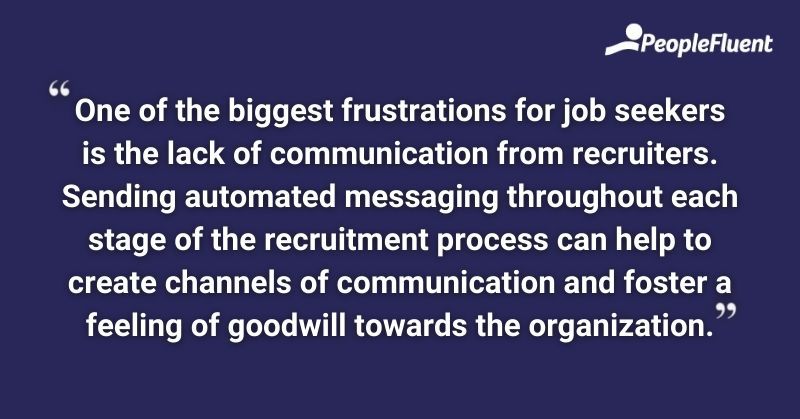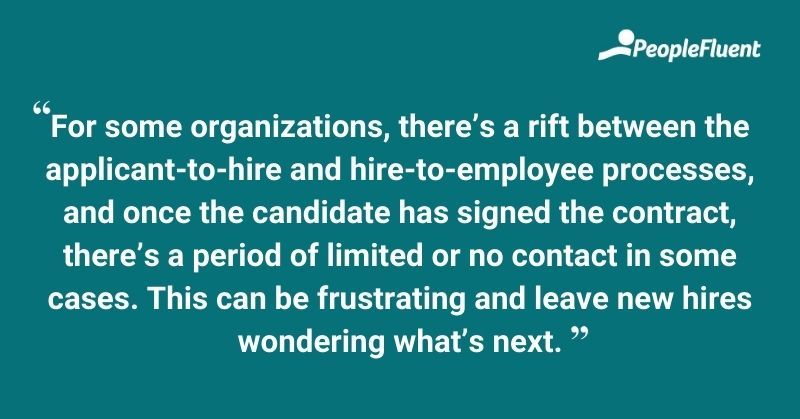Published: Nov 16, 2021Time to read: 5mins Category: Talent Management
8 Uses of Automation in Your Recruitment Process
Recruitment is arguably one of your HR department’s most business-critical functions. Getting it right is crucial. Finding ways to streamline the process can improve the candidate experience and allow for smarter planning using your ATS.
If your recruitment team finds that they’re inundated with resumes and unable to respond to applicants in a timely manner, your reputation may start to suffer. Automation could be your most valuable tool. From candidate attraction to onboarding, creating a seamless end-to-end experience can make all the difference.
Why Should You Automate Your Recruitment Strategy?
Candidates want clarity in their application process and they notice when you don’t respond. One survey found that 52% of candidates say they get frustrated most by the lack of response from potential employers during the job search process. Despite this, according to Talent Board, 53% of candidates don’t receive a response until three months after applying.
If they feel sidelined by your company’s poor communication, people may make their dissatisfaction known. This feedback can hurt your organization’s reputation, and in a landscape where recruiters are struggling to entice the best candidates to apply for roles, it’s important to be aware of how your organization is perceived.
Here are eight ways to take advantage of automation to streamline your recruitment efforts.

RELATED READING | ‘How to Create a Strong Recruiting Program’
1. Talent Pipelining
Automated recruitment processes can routinely analyze candidates in your Applicant Tracking System (ATS) to determine eligibility. If the candidates are currently inactive you can target them with automated messages to reestablish them into your talent pipeline. If the potential candidates were previously unsuccessful in their application for roles in your organization they may still be interested in similar vacancies in the future. Using automation to assist in candidate sourcing can cut down on the time spent searching for talented candidates, leaving recruiters with more time to focus on engaged leads.
2. Automated Messages
One of the biggest frustrations for job seekers is the lack of communication from recruiters. Sending automated messaging throughout each stage of the recruitment process can help to create channels of communication and foster a feeling of goodwill towards the organization, whether that application is successful or not. When you move a candidate along each stage, automated messages informing them of their progress can be sent in the form of SMS or email. Responses can vary depending on the role, whether the candidate is successful or not, or what your pipeline looks like.
3. Interview Scheduling
If scheduling a candidate interview involves multiple exchanges between department heads and recruiters, it’s time for a new approach. Rather than going back-and-forth with your candidate across departments and wasting valuable time on trying to schedule interviews with interviewers who already have full and demanding schedules of their own, automated interview scheduling puts candidates in control of their own interview times. Integrating calendars with the interviewer’s own allows for a scheduling model that can automatically place candidates in open slots.

HANDPICKED FOR YOU | ‘6 Ways to Choose the Right Applicant Tracking System for Your Organization’
4. Candidate Pre-Screening
Automating pre-screening can be helpful to eliminate clients who don’t meet the basic requirements of the role. By filtering skills or experience based on keywords, pre-screening can help to narrow down the selection. This can save recruiters time conducting preliminary telephone interviews and help to ensure that only suitable candidates are shortlisted. Instead, time can be spent to assess whether hires have the right personalities and culture fit for the role.
5. Due Diligence Checks
For some roles, you may need to request background checks. Since handling this information can be time-consuming, automating the process can make it a hands-off experience, and cut down the length of time taken to complete the checks.
6. Skills and Aptitude Testing
You’ll know the sort of skillset and mindset that you want your employees to bring to the business and it is important to test for those before the candidate progresses further along the application path. The testing process can be both bespoke and automated, and questionnaires in the form of video or text can streamline this part of the candidate’s journey. Automation allows you to compare the caliber of candidates to select those most suitable to progress further based on their responses to questions.
7. Candidate Preboarding and Onboarding
For some organizations, there’s a rift between the applicant-to-hire and hire-to-employee processes, and once the candidate has signed the contract, there’s often a period of limited or no contact. This can be frustrating and leave new hires wondering what’s next.
Automating the preboarding and onboarding process means that your new hire has all of the information they need before their first day. From login details to the particulars of any systems used, it can even give them a feel for their team. New team members can be fed welcome emails, company information, and any other relevant details to help them get up and running from the outset. In remote and hybrid environments, this can help to make up for what is lost in terms of company culture.

ALSO READ | ‘Employee Experience: How to Manage Before Day One… and Beyond’
8. Reporting and Analytics
When using an ATS, data is recorded, tracked, and stored in a single database. Candidates are tracked as soon as they start the application process, so by automating your reporting you can find ways to make the best use of this data. Automating your reporting processes allows you to gather and analyze data more quickly to make better-informed hiring decisions. Any uncertainties, such as how long it takes to fill a position, where candidates are sourced from, or why they’re dropping off, can become clear and appropriate action taken in a timely fashion.
MORE FROM THE BLOG | '4 Tips to Improve Candidate Experience for High-Volume Recruiting'
Streamline Your Recruitment Process
To learn more about leveraging automation in your recruitment strategy, listen to a recording of the webinar, ‘Stop Ghosting Your Candidates: How Automated Messages Will Improve Your Candidate Experience.' Or alternately, reach out to get a demo!